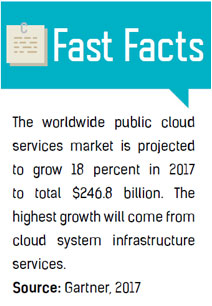THANK YOU FOR SUBSCRIBING

Pitching the Cloud
Anthony Stevens, Chief Digital Officer, Partner, Digital Transformation & Growth Leader, Kpmg Australia


Anthony Stevens, Chief Digital Officer, Partner, Digital Transformation & Growth Leader, Kpmg Australia
A CIO’s Take on What it Takes to Pitch Cloud Services.
I want to talk to you about the cloud, but please keep it to yourself. There are a few trade secrets in here that are probably best kept under wraps and wheeled out without notice or fanfare but with confidence and composure.
Business models of the future will be built on cloud services. In fact, forget that, business models of today are built on cloud services. The problem is that the way cloud services are sold is what’s limiting growth. Let’s fix that. The cloud services available in the market today are extraordinary. Anyone that suggests that cloud services aren’t ready yet, aren’t mature, or are missing features has either been misled or has been living under a rock for a while.
But I believe that at least some of those responsible for selling cloud services are not doing so very well. There’s so much opportunity out there that, rather than another dollar spent on R&D, we need to invest in the way in which cloud services are sold.
As a CIO, I often get asked what I’m looking for when evaluating a cloud service. What I don’t care about that much is the feature set. A vision, yes. Pedigree, yes. A roadmap yes, but you can leave the speeds and feeds at the door. Here’s why. New versions of these cloud services are being released so fast that in an enterprise IT context, what you actually use and deploy is going to be different from what you see through the sales cycle. Embrace this reality. In fact, love it.
When you sign a contract you commit to certain things but rarely the feature and function mix which you’ve been shown through the sales cycle. There’s no question though that fierce battles continue to rage between vendors in terms of features but frankly there’s a different battle we need to fight.
For the last few decades, the process of sales in IT has been a case of establishing a need, pitching a product’s features, haggling on price and providing a degree of support through a partner or services arm of your business to help get the product up and running. We all know that products will have bugs, features will improve over time and with that then there’s a maintenance and support fee (which is where the big money is made).
But Times have Changed
Now it’s a completely different game, so let’s start with the economic buyer – the person with the cheque book (or at least so you think). In some cases that’s still the same IT decision maker as before, but more often now while they may think they are making the decisions they are in fact representing a completely different business stakeholder.
The Upshot For All Those In The Business Of Selling Cloud Services Is That The Dialogue You Have With Your Customer Needs To Change
The First Challenge then is, Who is your Customer and How do you Manage IT?
Should you start selling to the business and bypass IT? Perhaps with some solutions but it’s likely to just create delays. My suggestion is to start to manage your customer base with a broader appreciation of stakeholders. The good news with this is that you’ll need to brush up on the idea of talking about issues other than bits and bytes.
Some of you in the sales game might be lucky enough to get goaled on lifetime contract values. Enjoy it while it lasts, as it’s not for long. The economics and nature of a cost variable service is such that this sort of ‘goaling’ doesn’t make sense. You should be paid on adoption and actual use of services.
So now, how do you sell? When selling cloud services, I’m convinced there’s two new languages you need to learn - finance and risk.
First, finance. To sell cloud services effectively (and win) you just have to understand the significant change; the way customers account for and manage their costs. If you don’t know what is the difference between a balance sheet and income statement (or P&L), then learn. In accounting, years ago, we bought assets and depreciated them over time. In the new world, consumption is a variable argument and involves the so-called “Opex versus Capex” discussion. Are assets classifiable as operational expenditure or should they be treated as capital (i.e. long-term) spending?
Ask about what’s committed; ask about whether what’s in place today is fully depreciated. Try to understand where there’s a re-charge regime in place and if so, why? And back we go again to who’s paying for what and why. This is a discussion about the new world of IT, not the old. So start your sales process with a discussion with a financial and accounting bent and don’t hold back in asking direct questions about budgets, share of wallet, discretionary spend, and the total cost of ownership of a service today. Most IT leaders will answer these questions directly and if they don’t, move on. Everyone is time poor.
Secondly, Risk – Which is not as Straightforward.
 Your starting premise should be to understand the risk profile of your target. Do they have, for example, on-premises equipment, in-house or outsourced staff, a local or co-located data centre? Draw up a profile and work out where and what you think the risks are. Line up your cloud services alongside the current view and identify the gap. That’s where the value is and milks it for all it’s worth.
Your starting premise should be to understand the risk profile of your target. Do they have, for example, on-premises equipment, in-house or outsourced staff, a local or co-located data centre? Draw up a profile and work out where and what you think the risks are. Line up your cloud services alongside the current view and identify the gap. That’s where the value is and milks it for all it’s worth.
Then there’s the question of the actual transfer of risk and how that works. Like it or not, you are going to need to work closely with someone in the commercial or legal team within your business. It’s hard but you need to work through what your offer is (or isn’t) when it comes to issues like protecting confidential data, privacy, warranties, or limitations of liability.
There’s no doubt that these are complex matters to work through but you’ll get stuck in a quagmire and the end of the sales cycle unless you have a position, a plan or understand some of these areas from your customer’s perspective.
The upshot for all those in the business of selling cloud services is that the dialogue you have with your customer needs to change. It’s hard and you’ll need some support to go through the process. Challenge your bosses and get them to show you how it’s done. If we get this right, there will be more growth, bigger commission checks, and happier customers. So the effort is certainly worth it.












